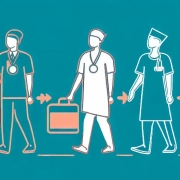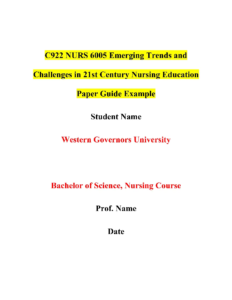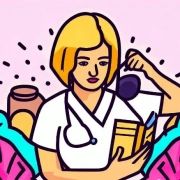Ways of Knowing Nursing Essay Example Ideas by Experts
 Introduction
Introduction
Florence Nightingale, the founder of modern nursing, recognized the importance of knowledge in nursing. Since then, many theorists in nursing have tried to identify the ways of knowing. However, it wasn’t until Carper’s seminal article in 1978 that the four ways of knowing were highlighted.
Carper identified four patterns of knowing in nursing: empirical, aesthetic, personal, and ethical knowing. Empirical knowing is the scientific knowledge that nurses acquire through research, observation, and experimentation. Aesthetic knowing is the art of nursing, which involves the use of intuition, creativity, and empathy to understand the patient’s needs. Personal knowing is the self-awareness and self-reflection that nurses use to understand their own biases, values, and beliefs. Ethical knowing is the understanding of ethical principles and values that guide nursing practice.
Carper’s work has been expanded upon by other theorists, such as Chinn and Kramer, who added two additional ways of knowing: emancipatory and sociopolitical knowing. Emancipatory knowing is the recognition of power imbalances in healthcare and the need to advocate for social justice. Sociopolitical knowing is the understanding of how social and political factors affect patient care.
While there have been identified different ways of knowing, these ways of knowing do not exist in isolation. The nurse must use knowledge from all domains to effectively care for the patient as each contributes to the nursing profession. Understanding their interplay and ongoing significance is crucial for nurses as they navigate the complexities of the healthcare landscape in the 21st century. In all areas of health care, knowledge is an important fundamental base for practice. As we navigate the complexities of modern healthcare, it becomes imperative to revisit and reevaluate these ways of knowing, considering the latest research findings and developments in the field in understanding how various ways of knowing inform nursing, education, and practice.
Exploring The Four Ways of Knowing in Nursing
Carper’s identification of four patterns of knowing in nursing, as outlined in her seminal 1978 article, has had a profound impact on the profession and remains a foundational concept for nursing students and practitioners alike. These four ways of knowing provide a comprehensive framework for understanding the diverse dimensions of nursing practice.
Empirical Ways of Knowing Nursing
Empirical knowing, often hailed as the bedrock of nursing practice, encompasses the systematic acquisition of knowledge through rigorous research, keen observation, and diligent experimentation (Carper, 1978). In essence, it constitutes the scientific foundation upon which nursing practice is built, equipping nurses with evidence-based insights and technical proficiency crucial for providing safe and effective patient care.
Within the dynamic landscape of contemporary nursing, empirical knowing continues to evolve, driven by the relentless pursuit of new research findings and the rapid integration of cutting-edge technologies into healthcare delivery (Beckett, 2021). This evolution underscores the critical importance of staying current with the latest developments in empirical knowledge, as it directly impacts the quality of patient care provided by nurses (Whalen, 2023).
Empirical knowing plays an indispensable role in clinical decision-making for nurses. When assessing patient conditions, making diagnostic evaluations, and devising treatment plans, nurses draw upon empirical knowledge to inform their choices and actions (Forough Rafii, et.al., 2021). This evidence-based approach ensures that nursing interventions align with the most up-to-date scientific evidence and best practices, ultimately leading to enhanced patient outcomes.
Moreover, empirical knowledge is foundational in comprehending the intricate workings of the human body and the mechanisms of diseases and treatments. It forms the basis upon which nurses build their expertise and competence, enabling them to provide optimal patient care (Smith et al., 2022). For instance, in the context of a patient presenting with chest pain in the emergency department, nurses leverage empirical knowledge to conduct comprehensive assessments, relying on the latest research findings and evidence-based guidelines to make accurate diagnoses and plan effective interventions.
In light of recent developments, empirical knowing in nursing has encountered unprecedented challenges and opportunities. The emergence of the COVID-19 pandemic has underscored the pivotal role of empirical knowledge in healthcare (De Kock et al., 2021). Nurses, armed with a robust understanding of empirical evidence, have played instrumental roles in managing the pandemic. They have been at the forefront of implementing evidence-based infection control measures, administering vaccines, and conducting research to deepen our understanding of the virus and its management (De Kock et al., 2021).
This adaptability of empirical knowing to rapidly evolving situations reaffirms its ongoing significance in nursing practice. Nurses must not only rely on established scientific principles but also possess the agility to apply empirical knowledge effectively in response to emerging healthcare challenges. The ever-expanding body of nursing research and technological advancements demand that nurses remain vigilant in their pursuit of empirical knowledge, ensuring that it remains a cornerstone of their practice, supporting the provision of the highest quality of care to patients.
Aesthetic Ways of Knowing Nursing
Aesthetic knowing often referred to as the art of nursing, is a fundamental dimension of nursing practice that transcends mere technical proficiency. Rooted in the principles of intuition, creativity, and empathy (Carper, 1978), it acknowledges that nursing is not just a science but also an art form that demands a profound connection with the human experience. Aesthetic knowing invites nurses to reach beyond the confines of routine procedures and engage with patients on a deeply human level.
This form of knowing empowers nurses to discern subtle cues from patients, facilitating a holistic understanding of their individual needs and preferences (Betriana et al., 2022). Aesthetic knowing encourages nurses to perceive each patient as a unique and multifaceted individual, allowing them to customize care approaches accordingly. In doing so, it elevates the overall patient experience and contributes to their well-being.
Moreover, aesthetic knowledge in nursing taps into our appreciation for beauty and artistry. It enables nurses to curate healing environments that promote patient comfort and relaxation, recognizing the significant impact aesthetics can have on a patient’s emotional and psychological well-being (Gregory, Stichler & Zborowsky, 2022). For instance, nurses can leverage aesthetic knowing to design patient rooms that create a soothing and uplifting atmosphere, fostering a sense of tranquility during the often stressful hospital stays.
In the contemporary landscape of nursing, the recognition of the vital role played by creativity and empathy in patient care has gained prominence (Muradov, Petrovskaya & Papathanassoglou, 2021). Recent research has illuminated the profound influence of aesthetic knowing on patient satisfaction and health outcomes. The integration of aesthetic knowing into patient-centered care has been linked to increased patient engagement and enhanced adherence to treatment plans (Carter, Creedy & Sidebotham, 2019). This aligns with the growing emphasis on patient experience as a key metric of healthcare quality.
Furthermore, the integration of technology has expanded the horizons of aesthetic knowing in nursing. Innovations such as virtual reality and art therapy interventions have been leveraged to alleviate pain and anxiety in patients, demonstrating the innovative ways in which aesthetic knowing can be harnessed to augment patient well-being (Carter, Creedy & Sidebotham, 2019). This ongoing exploration of aesthetic knowing’s applications underscores its transformative potential in modern nursing.
In essence, aesthetic knowing in nursing is not a separate entity but rather an integral part of the holistic care approach. It bridges the realms of science and art, enriching nursing practice and enhancing the quality of patient care. As nursing continues to evolve, nurses are encouraged to nurture and apply aesthetic knowing, recognizing its capacity to create profound and meaningful connections with patients while promoting healing and well-being.
Personal Ways of Knowing Nursing
Personal knowing in nursing centers on the critical aspects of self-awareness and self-reflection. Nurses engage in introspection to discern their own biases, values, and beliefs, recognizing the profound influence these personal factors can exert on their interactions with patients (Carper, 1978). It is through this introspective process that nurses can strive to provide culturally competent and patient-centered care, rooted in empathy and genuine respect.
Acknowledging and addressing personal biases is not merely a theoretical exercise; it is an essential component of building therapeutic relationships with patients (Campbell et.al., 2018). Personal knowing empowers nurses to approach each patient with an open mind, free from preconceived notions or judgments. This approach fosters trust and rapport, essential elements of effective patient care, and enhances the overall patient experience.
Personal knowledge in nursing is deeply rooted in the nurse’s own life experiences and observations. It recognizes that each patient is a unique individual with distinct needs and preferences, emphasizing the importance of empathy and refined interpersonal skills in forging meaningful connections (Whalen, 2023). The ability to tailor care to the idiosyncrasies of each patient is a hallmark of personal knowing.
Consider a scenario where a patient, confined to the hospital for an extended period, displays non-compliance and resistance to care. In such instances, personal knowledge becomes paramount as the nurse draws upon their intuition and empathy to comprehend the patient’s perspective. Through empathetic understanding, nurses can foster therapeutic relationships that promote cooperation and enhance the patient’s overall well-being.
In the contemporary landscape of healthcare, characterized by cultural diversity and the imperative of cultural competence, personal knowing retains its status as an indispensable facet of nursing practice (Higginbottom et al., 2019). Nurses are increasingly encouraged to embark on journeys of self-reflection, uncovering and addressing their biases and preconceived assumptions. Recent studies underscore the pivotal role of personal knowing in establishing trust and rapport, particularly when caring for patients from diverse backgrounds (Graham, 2022). By embracing their own biases, nurses contribute to the creation of an inclusive healthcare environment, where patients feel valued, respected, and truly understood.
Furthermore, the advent of telehealth and virtual care platforms has presented novel challenges for personal knowing. Nurses providing care through digital channels must navigate the intricacies of non-verbal communication and cultural sensitivity in innovative ways (Kolluri et al., 2022). The dynamic healthcare landscape necessitates that nurses continually nurture and cultivate personal knowing to effectively meet the evolving needs of their diverse patient populations.
In essence, personal knowing in nursing is not a static concept but rather a dynamic force that drives continuous self-improvement and personal growth. It enhances the nurse’s ability to provide patient-centered care, underpinned by empathy, cultural competence, and a genuine commitment to the well-being of each patient.
Ethical Ways of Knowing Nursing
Ethical knowing in nursing encompasses a profound understanding of the ethical principles and values that underpin the profession (Carper, 1978). In the daily practice of nursing, healthcare professionals often confront complex moral dilemmas, and ethical knowing equips them with a sturdy framework for navigating these intricate challenges. It is founded on an unwavering commitment to uphold the ethical standards of the nursing profession while placing the well-being and rights of patients at the forefront.
At its core, ethical knowing demands that nurses make decisions that align with fundamental ethical principles, including autonomy, beneficence, non-maleficence, and justice (Beauchamp & Childress, 2019). This ethical foundation ensures that patient care is consistently conducted with the utmost integrity and adherence to ethical guidelines, thereby preserving the trust and confidence that patients and their families repose in healthcare professionals.
Ethical knowledge is firmly rooted in individual moral compasses and deeply held values. It serves as a guiding light for nurses as they navigate the complex and often ethically fraught landscape of healthcare. This knowing involves a comprehensive understanding of various ethical frameworks and philosophies, providing nurses with the tools necessary to make ethically sound decisions (Hou et al., 2021).
In practice, ethical knowing becomes particularly salient when nurses are confronted with challenging decisions, such as determining the most appropriate course of action in situations where they must weigh the benefits and risks of a particular treatment. In such instances, nurses rely on their ethical knowledge to ensure that the chosen path aligns harmoniously with the best interests of the patient and remains steadfast in upholding ethical principles.
In an era marked by continually evolving healthcare paradigms and the emergence of novel ethical considerations, nurses’ commitment to ethical knowing has assumed greater significance (De Melo-Martín et al., 2019). Recent developments in healthcare, including gene editing and the integration of artificial intelligence in diagnostics and treatment, have introduced unique ethical challenges. Nurses find themselves grappling with questions concerning patient consent, privacy, and the equitable distribution of resources.
The COVID-19 pandemic, in particular, has placed immense ethical demands on nurses. They have been tasked with making arduous decisions related to resource allocation, triage protocols, and providing emotional support to patients and their families (Smith et al., 2021). Ethical knowing serves as a moral compass in these trying circumstances, offering guidance and principles to nurses as they navigate these intricate ethical landscapes. It reinforces the enduring commitment to patient-centered care, ensuring that patients’ needs and well-being remain paramount in all decision-making processes.
In essence, ethical knowing is not merely an abstract concept; it is a dynamic force that guides nurses in upholding the highest ethical standards of the profession. It empowers nurses to make ethically sound decisions, fostering trust, and preserving the core values of nursing as they navigate the complex moral terrain of healthcare.
Expanding the Ways of Knowing in Nursing
Carper’s pioneering work in identifying four fundamental patterns of knowing in nursing laid a robust foundation for the profession. However, the dynamic nature of healthcare and nursing practice has spurred subsequent nursing theorists to explore and expand upon these essential concepts. Among these trailblazing efforts, Chinn and Kramer (2018) introduced two additional ways of knowing: emancipatory and sociopolitical knowing, which have broadened the scope of nursing knowledge and practice.
Emancipatory Ways of Knowing Nursing
Emancipatory knowing in nursing represents a transformative conceptual framework that confronts the pervasive issue of power imbalances within healthcare systems and society at large. As introduced by Chinn and Kramer (2018), this form of knowing empowers nurses to recognize, question, and challenge oppressive structures and practices within healthcare institutions. More significantly, it equips nurses to be catalysts for social justice, advocating for marginalized and vulnerable patient populations to ensure equitable access to healthcare resources and services.
At its core, emancipatory knowing underscores the nurse’s pivotal role in effecting positive social change within healthcare. Nurses are uniquely positioned to identify and address systemic inequities that adversely affect patient access to quality care. This includes advocating for policies, practices, and interventions that promote equity and fairness in healthcare delivery. By leveraging their knowledge and influence, nurses can contribute to dismantling barriers and fostering an environment where all individuals, regardless of their background or circumstances, can access and receive the care they need (Kagan et al., 2010).
Emancipatory knowing in nursing extends beyond the confines of healthcare institutions. It recognizes the broader societal context in which healthcare operates and the pervasive impact of social, economic, and political factors on health outcomes. Nurses who embrace this form of knowing engage in critical reflection and analysis of the structural and systemic forces that perpetuate health disparities and inequalities (Chinn & Kramer, 2018).
By developing a deep awareness of these issues, nurses can actively challenge and confront the root causes of health inequities. This may involve advocating for policy changes, participating in community initiatives, and collaborating with interdisciplinary teams to address the social determinants of health that disproportionately affect vulnerable populations. Emancipatory knowing compels nurses to be advocates for social justice not only within the clinical setting but also in their communities and on a broader scale (Mason et al., 2020).
In an era marked by increasing awareness of health disparities and the pressing need for healthcare equity, the incorporation of emancipatory knowing into nursing education and practice is paramount. Recent events, such as the COVID-19 pandemic, have laid bare the deep-seated inequities in healthcare access and outcomes. Nurses, armed with an understanding of emancipatory knowing, have a vital role to play in addressing these disparities and advocating for change (Smith et al., 2021).
Sociopolitical Ways of Knowing Nursing
Sociopolitical knowing in nursing is a multifaceted form of knowledge that emphasizes the understanding of how social and political factors intersect with healthcare. As introduced by Chinn and Kramer (2018), this way of knowing acknowledges that healthcare is inextricably linked to the broader sociopolitical landscape. It underscores the profound impact of policies, regulations, and societal norms on patient care and healthcare delivery.
At its essence, sociopolitical knowing requires nurses to be acutely aware of the societal context in which healthcare is delivered. This encompasses issues related to healthcare policies, socioeconomic disparities, cultural norms, and the intricate interplay of social and political forces (Chinn & Kramer, 2018). Nurses who possess sociopolitical knowing are well-equipped to navigate the complexities of the healthcare system and address the social determinants of health that significantly influence their patients’ well-being.
One fundamental aspect of sociopolitical knowing involves sensitivity to the personal goals and values of others, as well as an understanding of society and politics. This knowledge enables nurses to approach patient care in a nonjudgmental manner when dealing with individuals and families who may hold diverse social and political views (Smith et al., 2021). It empowers nurses to make care decisions that respect and acknowledge what is important to patients, regardless of their sociopolitical beliefs.
Moreover, nurses who embrace sociopolitical knowing are poised to be effective advocates on behalf of their patients and communities. They recognize that healthcare is not solely confined to the clinical setting but is deeply intertwined with broader societal issues. Armed with a heightened awareness of how external factors impact health, nurses can actively engage in healthcare policy advocacy, addressing healthcare disparities and working toward a more just and equitable healthcare system (Mason et al., 2020).
In today’s rapidly evolving healthcare landscape, nurses must navigate an array of sociopolitical challenges. Issues such as access to care, health equity, and the allocation of healthcare resources are shaped by societal norms, political decisions, and economic forces. Nurses who possess sociopolitical knowing are well-prepared to engage in discussions and actions aimed at addressing these critical issues and advocating for the best interests of their patients and communities (Smith et al., 2021).
For instance, nurses played pivotal roles in advocating for expanded access to healthcare during the COVID-19 pandemic, emphasizing the importance of equitable distribution of vaccines, testing, and treatment options (Smith et al., 2021). Their understanding of the sociopolitical landscape and its impact on healthcare allowed them to advocate for evidence-based policies that prioritized public health and the well-being of vulnerable populations.
The Interplay of Ways of Knowing in Nursing: A Holistic Approach to Patient Care
In the realm of nursing, the ways of knowing, including empirical, aesthetic, personal, ethical, emancipatory, and sociopolitical knowing, are not isolated domains of knowledge but rather interconnected facets that converge in the dynamic practice of healthcare (Betriana et al., 2022). Nurses draw upon these diverse ways of knowing simultaneously to provide comprehensive and patient-centered care, recognizing that patient needs and circumstances often require a multifaceted approach.
For instance, consider the assessment of a patient’s pain—a common scenario in nursing practice. In this situation, a nurse must seamlessly integrate multiple ways of knowing. Empirical knowledge informs the nurse about evidence-based pain management strategies, ensuring that the patient receives appropriate and effective interventions (Forough Rafii, et.al., 2021). Aesthetic knowing comes into play as the nurse keenly observes the patient’s non-verbal cues, interpreting facial expressions and body language to gain insights into the nature and intensity of pain (Betriana et al., 2022). Personal knowing encourages the nurse to engage in self-reflection, acknowledging and addressing any biases or assumptions that may affect the assessment and management of pain (Thorne, 2020). Ethical knowing ensures that pain relief interventions align with the patient’s values and autonomy, respecting their right to make decisions about their care (Beauchamp & Childress, 2019).
This interconnectedness of ways of knowing exemplifies the complexity of nursing practice. It underscores the importance of nurses’ ability to navigate and apply various forms of knowledge simultaneously, ultimately enhancing the quality of care provided to patients. Furthermore, the synergy among these ways of knowing contributes to a holistic and patient-centered approach to healthcare, aligning with the profession’s core values and principles.
Understanding the interplay of these ways of knowing is particularly pertinent in the 21st-century healthcare landscape. As healthcare continues to evolve with advancements in technology, changing demographics, and shifting societal expectations, nurses must adapt to meet the evolving needs of patients and communities (Whalen, 2023). Each way of knowing contributes uniquely to the nursing profession, providing valuable insights and perspectives that enrich patient care.
In light of these ongoing changes and developments in healthcare, nurses are challenged to revisit and reevaluate these ways of knowing. By doing so, they can ensure that their practice remains aligned with the latest research findings and evidence-based guidelines (Smith et al., 2022). Embracing a holistic approach to knowledge allows nurses to remain nimble and adaptable while upholding their commitment to delivering compassionate, patient-centered, and evidence-based care.
Conclusion
In conclusion, the exploration of ways of knowing in nursing underscores the complexity and interconnectedness inherent in nursing practice. The foundational recognition by Florence Nightingale of the pivotal role of knowledge in nursing has paved the way for a profound understanding of how different dimensions of knowledge contribute to the nursing profession. Carper’s identification of empirical, aesthetic, personal, and ethical knowing, complemented by Chinn and Kramer’s addition of emancipatory and sociopolitical knowing, has provided nurses with a comprehensive framework for delivering patient-centered care.
These ways of knowing do not operate in isolation but rather converge and interact dynamically in the ever-evolving practice of nursing. Nurses skillfully draw upon empirical knowledge to make evidence-based decisions, employ aesthetic knowing to forge meaningful connections with patients, engage in personal knowing to address biases and values, and apply ethical knowing to navigate complex moral quandaries. Emancipatory knowing empowers nurses to be advocates for social justice, while sociopolitical knowing equips them to understand the broader societal context shaping healthcare.
In the 21st century, the nursing profession is continually transformed by technological advancements, demographic shifts, and evolving healthcare paradigms. As nurses navigate these intricate challenges, it becomes imperative to reassess and reevaluate these ways of knowing, incorporating the latest research findings and emerging developments in the field. By embracing a holistic approach to knowledge, nurses can remain adaptable and resilient, delivering care that is both compassionate and evidence-based, thus upholding the core values of the nursing profession. In this ongoing journey, nurses pay homage to the legacy of Florence Nightingale and continue the noble pursuit of excellence in nursing practice.
References
Beauchamp, T. L., & Childress, J. F. (2019). Principles of biomedical ethics (8th ed.). Oxford University Press, USA.
Beckett, C. D. (2021). The evidence-based practice certificate and the nursing professional development evidence-based practice Academy. Journal for Nurses in Professional Development, 37(4), 189-191. https://doi.org/10.1097/nnd.0000000000000772
Betriana, F., Kongsuwan, W., & Mariyana, R. (2022). Aesthetics in nursing practice as experienced by nurses in Indonesia: A phenomenological study. Belitung Nursing Journal, 8(1), 20-27. https://doi.org/10.33546/bnj.1958
Campbell, T. D., Penz, K., Dietrich-Leurer, M., Juckes, K., & Rodger, K. (2018). Ways of knowing as a framework for developing reflective practice among nursing students. International Journal of Nursing Education Scholarship, 15(1). https://doi.org/10.1515/ijnes-2017-0043
Carper, B. A. (1978). Fundamental patterns of knowing in nursing. Advances in Nursing Science, 1(1), 13-24. https://doi.org/10.1097/00012272-197810000-00004
Carter, A. G., Creedy, D. K., & Sidebotham, M. (2019). The interplay of ways of knowing in midwifery practice: A sociocultural perspective. Midwifery, 74, 41-47.
Chinn, P. L., & Kramer, M. K. (2018). Knowledge development in nursing: Theory and process (10th ed.). Elsevier.
De Kock, J. H., Latham, H. A., Leslie, S. J., Grindle, M., Munoz, S., Ellis, L., Polson, R., & O’Malley, C. M. (2021). A rapid review of the impact of COVID-19 on the mental health of healthcare workers: Implications for supporting psychological well-being. BMC Public Health, 21(1). https://doi.org/10.1186/s12889-020-10070-3
Forough Rafii, Alireza Nikbakht Nasrabadi, & Fereshteh Javaheri Tehrani. (2021). How nurses apply patterns of knowing in clinical practice: A grounded theory study. Ethiopian Journal of Health Sciences, 31(1). https://doi.org/10.4314/ejhs.v31i1.16
Graham, M. M. (2022). Navigating professional and personal knowing through reflective storytelling amidst COVID-19. Journal of Holistic Nursing, 40(4), 372-382. https://doi.org/10.1177/08980101211072289
Gregory, D. D., Stichler, J. F., & Zborowsky, T. (2022). Adapting and creating healing environments: Lessons nurses have learned from the COVID-19 pandemic. Nurse Leader, 20(2), 201-207. https://doi.org/10.1016/j.mnl.2021.10.013
Higginbottom, G. M., Safipour, J., Yohani, S., O’Brien, B., Mumtaz, Z., Paton, P., Chiu, Y., & Barolia, R. (2019). An ethnographic investigation of the maternity healthcare experience of immigrants in rural and urban Alberta, Canada. BMC Pregnancy and Childbirth, 16(1). https://doi.org/10.1186/s12884-015-0773-z
Hou, Y., Timmins, F., Zhou, Q., & Wang, J. (2021). A cross-sectional exploration of emergency department nurses’ moral distress, ethical climate and nursing practice environment. International Emergency Nursing, 55, 100972. https://doi.org/10.1016/j.ienj.2021.100972
Kagan, P. N., Smith, M. C., Cowling III, W. R., & Chinn, P. L. (2010). A nursing manifesto: An emancipatory call for knowledge development, conscience, and praxis. Nursing Philosophy, 11(1), 67-84. https://doi.org/10.1111/j.1466-769x.2009.00422.x
Kolluri, S., Stead, T. S., Mangal, R. K., Coffee, R. L., Littell, J., & Ganti, L. (2022). Telehealth in response to the rural health disparity. Health Psychology Research, 10(3). https://doi.org/10.52965/001c.37445
Mason, D. J., Perez, A., McLemore, M. R., & Dickson, E. (2020). Policy & politics in nursing and health care – E-book. Elsevier Health Sciences.
Muradov, O., Petrovskaya, O., & Papathanassoglou, E. (2021). Effectiveness of cognitive interventions on cognitive outcomes of adult intensive care unit survivors: A scoping review. Australian Critical Care, 34(5), 473-485. https://doi.org/10.1016/j.aucc.2020.11.001
Smith, L., Amlȏt, R., Lambert, H., Oliver, I., Robin, C., Yardley, L., & Rubin, G. (2020). Factors associated with adherence to self-isolation and lockdown measures in the UK: A cross-sectional survey. Public Health, 187, 41-52. https://doi.org/10.1016/j.puhe.2020.07.024
Thorne, S. (2020). Rethinking Carper’s personal knowing for 21st century nursing. Nursing Philosophy, 21(4). https://doi.org/10.1111/nup.12307
Whalen, M. (2023). Transforming evidence-based practice education in nurse residency programs: A call to action. Nursing Outlook, 71(3), 101959. https://doi.org/10.1016/j.outlook.2023.101959
Unlock Your Academic Success with ReliablePapers.com – Your Trusted Nursing Essay Writing Service!
Are you facing the daunting task of writing a nursing essay or coursework? At ReliablePapers.com, we understand that some nursing topics can be incredibly challenging, and tight deadlines can add to the pressure. That’s why we’re here to offer you the best nursing paper writing service in the business.
Our team of expert essay writers is ready to assist you, whether you need a custom essay, nursing assignment help, or even a sample of a nursing phenomenon of interest paper. With us, no topic is too complex, no deadline is too tight, and no instructions are too specific.
When you choose ReliablePapers.com, you’re choosing reliability, quality, and convenience. Our nursing paper writers will craft a unique, customized essay just for you, from scratch, ensuring it aligns perfectly with your requirements.
Save your precious time for what truly matters by entrusting your academic success to the professionals at ReliablePapers.com. Our nursing paper writing services are the key to unlocking your full potential in the world of nursing studies.
Get to enjoy our comprehensive range of services, including nursing paper writing, nursing coursework help, and nursing assignment help among others. Let us be your academic partners on your journey to success.
Hire an Expert Paper Writer on Any Subject, Any Topic, Any Deadline! Submit your paper instructions by placing your order here to get started!



 C922 NURS 6005 Emerging Trends and Challenges in 21st Century Nursing Education
C922 NURS 6005 Emerging Trends and Challenges in 21st Century Nursing Education Nurses play a vital and diverse role when it comes to managing medications. This involves a broad spectrum of duties that directly impact patient safety and the overall quality of healthcare delivery. Indeed, the role of nurses in medication management is multifaceted, encompassing both legal and ethical considerations. Nurses bear a dual responsibility anchored in a framework of legal regulations and ethical principles that guide their practice, particularly when it comes to the intricate task of managing medications. These responsibilities extend beyond the confines of their duty hours, requiring unwavering commitment to adhering to specific guidelines defining their scope of practice, as delineated by the American Nurses Association in 2021. This comprehensive scope meticulously outlines what nurses can and cannot do, specifying their competencies, responsibilities, and qualifications.
Nurses play a vital and diverse role when it comes to managing medications. This involves a broad spectrum of duties that directly impact patient safety and the overall quality of healthcare delivery. Indeed, the role of nurses in medication management is multifaceted, encompassing both legal and ethical considerations. Nurses bear a dual responsibility anchored in a framework of legal regulations and ethical principles that guide their practice, particularly when it comes to the intricate task of managing medications. These responsibilities extend beyond the confines of their duty hours, requiring unwavering commitment to adhering to specific guidelines defining their scope of practice, as delineated by the American Nurses Association in 2021. This comprehensive scope meticulously outlines what nurses can and cannot do, specifying their competencies, responsibilities, and qualifications. D219 NURS 3610 Scholarship in Nursing Practice
D219 NURS 3610 Scholarship in Nursing Practice
 Assignment Instructions Overview
Assignment Instructions Overview

